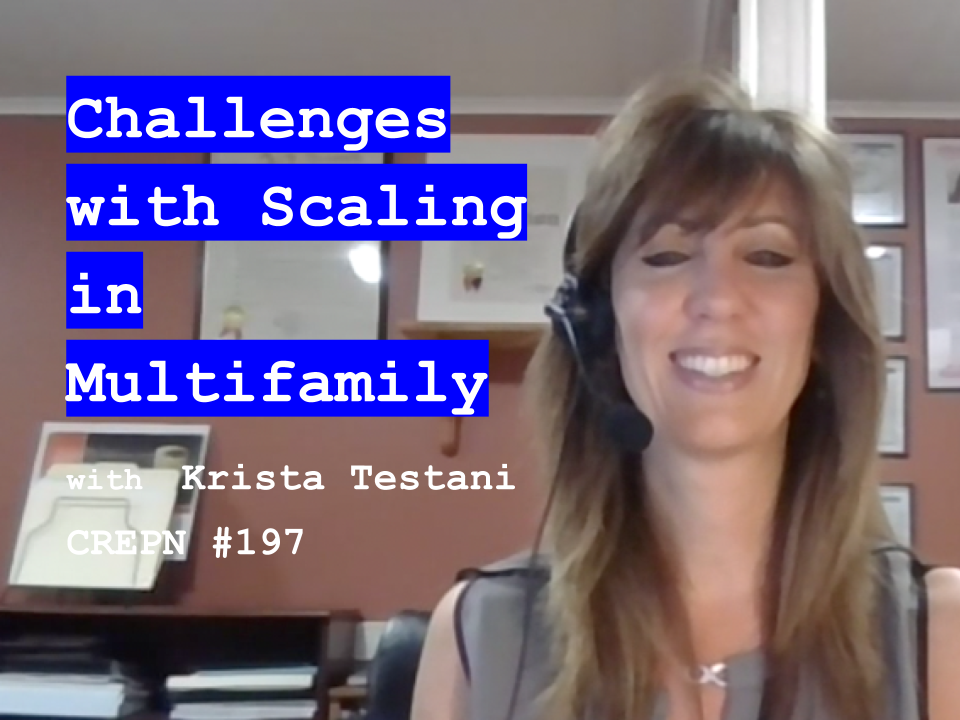
23 May Challenges with Scaling in Multifamily with Krista Testani – CREPN #197
The Challenges with scaling in Multifamily faced by investors trying to grow are avoidable, if you are willing to learn from others.Krista Testani quit her law practice cold turkey for real estate. Together with her firefighter husband, they started flipping single family homes on Long Island, NY, in 2007. Initially the margins were healthy, and the number of opportunities were unlimited.
By 2011, competitors were everywhere. Profit margins were shrinking and the supply of available properties started to dry up. This is when Krista recognized, in order to scale her real estate investment business, she needed to get into larger properties.
Flipping single family homes does not naturally lead to multifamily. While both flipping and multifamily are real estate, they are dramatically different. Flipping homes is buying, fixing and selling, quickly for a profit. Multifamily is a business with ongoing operations. It requires you to dive deep into due diligence to find the operational or physical changes you can change to improve the value over the next couple of years.
To learn the ins and outs of multifamily, Krista worked with a mentor who showed her the possibilities in multifamily to scale her real estate business. While she understood how multifamily worked, it was the action steps, the doing, that kept her from instant success.
Fortunately for you, she shares the lessons she learned below. These are the specific steps that will help you propel your multifamily business and achieve the success you desire.
Challenges with Scaling in Multifamily
The challenges with scaling in multifamily are many. You can either go it alone and grind your way, or you can learn from others who have gone before you. The following are lessons recognized by Krista that she recommends doing to accelerate your growth.
Krista recognizes two levels of marketing in multifamily syndication; micro and macro. Micro is the technical learning. Getting to know the brokers and developing your systems so you can analyze a property quickly to determine if a property is an opportunity. To accelerate your growth curve in the micro, consider working with a mentor with success in multifamily. Then look and analyze a lot of deals.
Macro is marketing. Marketing to potential investors. Sharing what you are learning with others. This is absolutely necessary when raising capital. Too often new investors believe they can only do after they master the micro. However, as Krista witnessed, other new investors, who started at the same time as she did, jumped into the macro. While she waited to talk with potential investors until she mastered the micro, her peers talked and talked.
They talked with others and shared what they were learning. The more they learned, the more they shared. This naturally created interest with potential investors, and stoked their interest. These potential investors were investing their time, and became passengers, along for the ride.
Because they had traveled the same leaning journey, raising money was easy. When Krista’s peers had a deal under contract, they were able to easily get financial commitments from the passengers they had been nurturing.
If you fail to nurture you potential investors, raising capital will be near impossible.
Market Yourself – Talk to People
Marketing yourself is absolutely necessary to grow and overcome the challenges with scaling your multifamily business. It can be a struggle if you make it difficult. However, if you are committed to grow in Multifamily, there are some easy ways to accomplish this. Remember, multifamily investing is a team sport. In order to close on larger properties, you need a team and willing investors.
Growing your investor list is much like gardening. In order to grow a successful garden you must plant some seeds. To make the seeds grow, you have to water, and make sure the seeds get sunlight. Not all seeds take root.
For multifamily investors, the seeds are conversations. A gardner has to scatter a lot of seeds to have a large crop. An investor has to have a lot of conversations.
The gardener gets to harvest their crop. For you the investor, the payoff comes when others know and trust that you know what you are doing. Not every seed will bear fruit, but if you talk to enough people, and generate enough interested, able investors, you will have no problem getting commitments when it is time to pull the trigger and close the deal.
How to Market Yourself:
Do you market yourself? You have to put yourself out there and let other know what you are doing, but how? The easiest way is to share what you are learning as you go with people you know. This allows you to have natural conversations with people who are interested in you and what you are doing. These conversations help you build your reputation and credibility as someone in multifamily real estate.
The more you share with others, the more comfortable you will become. Your conversations will lead to questions that require you to find the answers. Questions are natural for anyone who is interested in learning more. When you find the answer, you have another reason to follow up with the person so you can share the answer to their question. All of these conversations are necessary to help you overcome the challenges with scaling in multifamily.
In a short amount of time, you will be recognized as someone who knows what they are doing. Why? Because you had the courage to have the conversations and you took the time to find the answers. All the while you built up your confidence and your reputation.
Now that you know what you are talking about, you can easily start talking with people you know less. Ask them what they do. When they ask you what you do, let them know that you are a multifamily investor.
Remember this, if you don’t tell others what you do, who will. If people do not know what you do, how will they make the decision to invest with you?
Network
Networking is one of the best ways to get to know others. You cannot do this sitting by yourself behind your computer. While you can do some initial networking over social media, eventually you have to meet face to face with others.
You can join a local real estate investment association REIA, Facebook or a MeetUp Group. If there are none in our area, start one. Again, you don’t have to be the expert. What you have to do is invest in your micro learning, and share this information with others.
The more organic, authentic relations you can develop, the more success you will have. Have conversations, be authentic and share the information you are learning with others.
Systems
Systems are key to developing your relationship database and overcoming the investor challenges with scaling in multifamily. Keep it simple to begin with. Consider using Google Docs. Ultimately, you are doing all of this to develop some relationships with investors who are willing to invest with you. To make certain they progress to the point of commitment, you need to track your conversations with them.
When you first meet them, make some notes. Are they experienced real estate investors? What are they currently investing in? Do they have some parameters that need to be met for them to invest? Do they have questions that you can research and get back to them with the answer? The answers to these will be important when you are trying to take a deal down.
As you make notes, you will find some common points of interest that will help you gauge the progress of interest. The quicker you set up a system, the faster you be able to recognize which prospects are able to commit and disqualify those who are not.
Keep in mind, just because one is not able to commit today, does not mean they will be unable to commit to your next deal. Follow up is key, so stay in touch.
Never Judge
Never judge people. You never know who may be interested in your opportunity. If you chose to not share your information, you may eliminate someone who is able to invest in your deal. You never know who knows who, and may be looking for the deal you have.
Krista thought her Facebook friends would be the last to be interested in investing with her in real estate. To her surprise, some of them had been interested in real estate, but did not know how to get into multifamily. Her post about multifamily provided a friend they could contact to learn more from .
We all have so many opportunities to network and can feel overwhelmed. If you are truly looking for some new investors, you have to be willing to share, and be willing to accept calls from strangers. Yeah, a lot of these will not develop into anything, but you never know who they know.
For the dedicated, willing investor, sharing yourself is key to overcoming the challenges with scaling in multifamily.
BIGGEST RISK
Each week I ask my guest what is the Biggest Risk they see that real estate investors face.
BIGGEST RISK: The BIGGEST RISK Micro – Crime and the cost increase in your insurance if there is a significant crime rate in the neighborhood where your property is located.
The BIGGEST RISK Macro: The next recession.
How to manage the risk:
Micro: Be aware of the crime statistics in the neighborhood and surrounding properties. Are they better or worse than your property? These will affect your insurance rates. It is difficult to lower a crime rate in a neighborhood all by yourself.
Macro: In order to be prepared for the next market correction, stress test your numbers. Know where the rents were during the last correction. Do your numbers still work if you have to lower your rents? Also, lock into long term interest rates. If the market changes, will you be able to continue to make your loan payments and ride out the correction? Stay out of tertiary markets. Stay in primary markets where there will be demand for housing. If using a bridge loan, get the ability to exercise an extension so that you can complete your value add and get through the correction.
For more go to
Website: www.sharplinequity.com
Email: krista@sharplineequity.com
Meetup: Multifamily Investing Unveiled

